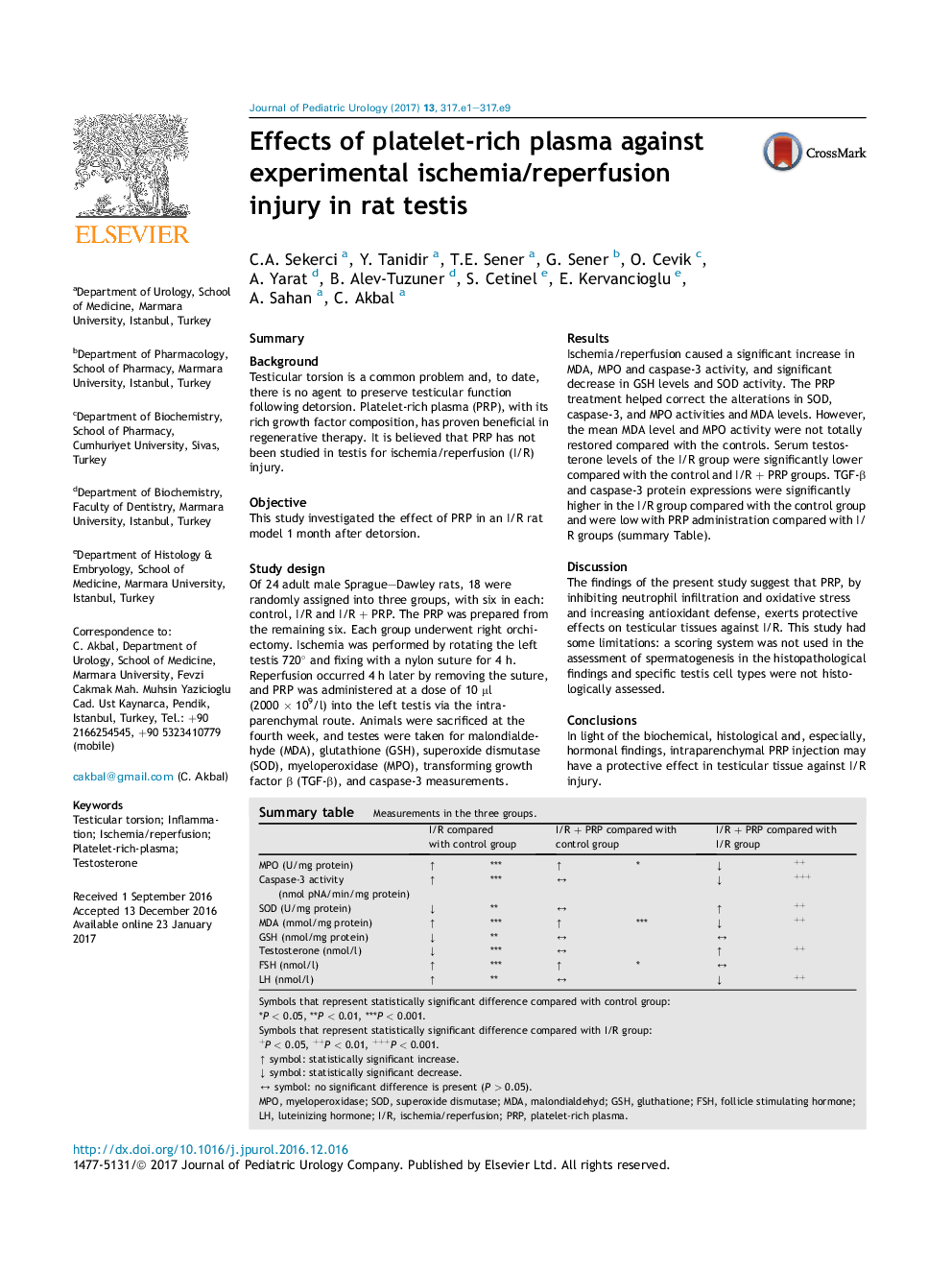| Article ID | Journal | Published Year | Pages | File Type |
|---|---|---|---|---|
| 5718616 | Journal of Pediatric Urology | 2017 | 9 Pages |
SummaryBackgroundTesticular torsion is a common problem and, to date, there is no agent to preserve testicular function following detorsion. Platelet-rich plasma (PRP), with its rich growth factor composition, has proven beneficial in regenerative therapy. It is believed that PRP has not been studied in testis for ischemia/reperfusion (I/R) injury.ObjectiveThis study investigated the effect of PRP in an I/R rat model 1 month after detorsion.Study designOf 24 adult male Sprague-Dawley rats, 18 were randomly assigned into three groups, with six in each: control, I/R and I/R + PRP. The PRP was prepared from the remaining six. Each group underwent right orchiectomy. Ischemia was performed by rotating the left testis 720° and fixing with a nylon suture for 4 h. Reperfusion occurred 4 h later by removing the suture, and PRP was administered at a dose of 10 μl (2000 Ã 109/l) into the left testis via the intraparenchymal route. Animals were sacrificed at the fourth week, and testes were taken for malondialdehyde (MDA), glutathione (GSH), superoxide dismutase (SOD), myeloperoxidase (MPO), transforming growth factor β (TGF-β), and caspase-3 measurements.ResultsIschemia/reperfusion caused a significant increase in MDA, MPO and caspase-3 activity, and significant decrease in GSH levels and SOD activity. The PRP treatment helped correct the alterations in SOD, caspase-3, and MPO activities and MDA levels. However, the mean MDA level and MPO activity were not totally restored compared with the controls. Serum testosterone levels of the I/R group were significantly lower compared with the control and I/R + PRP groups. TGF-β and caspase-3 protein expressions were significantly higher in the I/R group compared with the control group and were low with PRP administration compared with I/R groups (summary Table).DiscussionThe findings of the present study suggest that PRP, by inhibiting neutrophil infiltration and oxidative stress and increasing antioxidant defense, exerts protective effects on testicular tissues against I/R. This study had some limitations: a scoring system was not used in the assessment of spermatogenesis in the histopathological findings and specific testis cell types were not histologically assessed.Summary table. Measurements in the three groups.I/R compared with control groupI/R + PRP compared with control groupI/R + PRP compared with I/R groupMPO (U/mg protein)â***â*â++Caspase-3 activity (nmol pNA/min/mg protein)â***ââ+++SOD (U/mg protein)â**ââ++MDA (mmol/mg protein)â***â***â++GSH (nmol/mg protein)â**ââTestosterone (nmol/l)â***ââ++FSH (nmol/l)â***â*âLH (nmol/l)â**ââ++Symbols that represent statistically significant difference compared with control group:*P < 0.05, **P < 0.01, ***P < 0.001.Symbols that represent statistically significant difference compared with I/R group:+P < 0.05, ++P < 0.01, +++P < 0.001.â symbol: statistically significant increase.â symbol: statistically significant decrease.â symbol: no significant difference is present (P > 0.05).MPO, myeloperoxidase; SOD, superoxide dismutase; MDA, malondialdehyd; GSH, gluthatione; FSH, follicle stimulating hormone; LH, luteinizing hormone; I/R, ischemia/reperfusion; PRP, platelet-rich plasma.ConclusionsIn light of the biochemical, histological and, especially, hormonal findings, intraparenchymal PRP injection may have a protective effect in testicular tissue against I/R injury.
